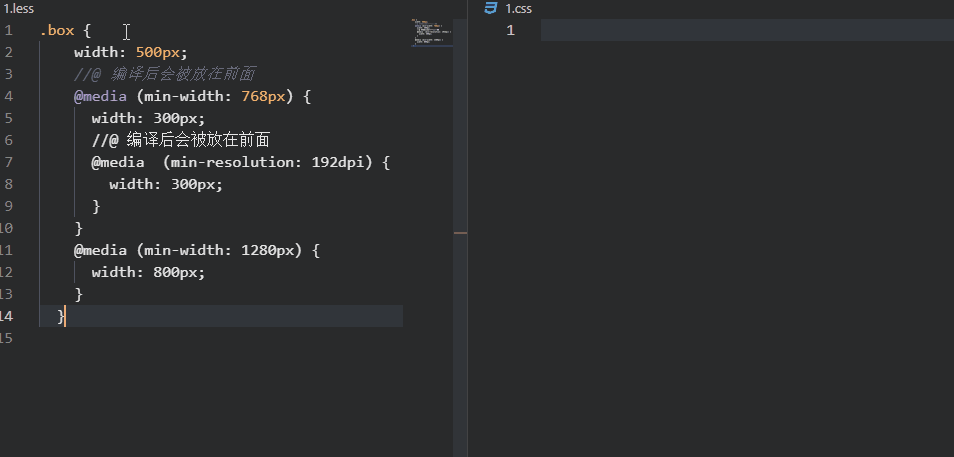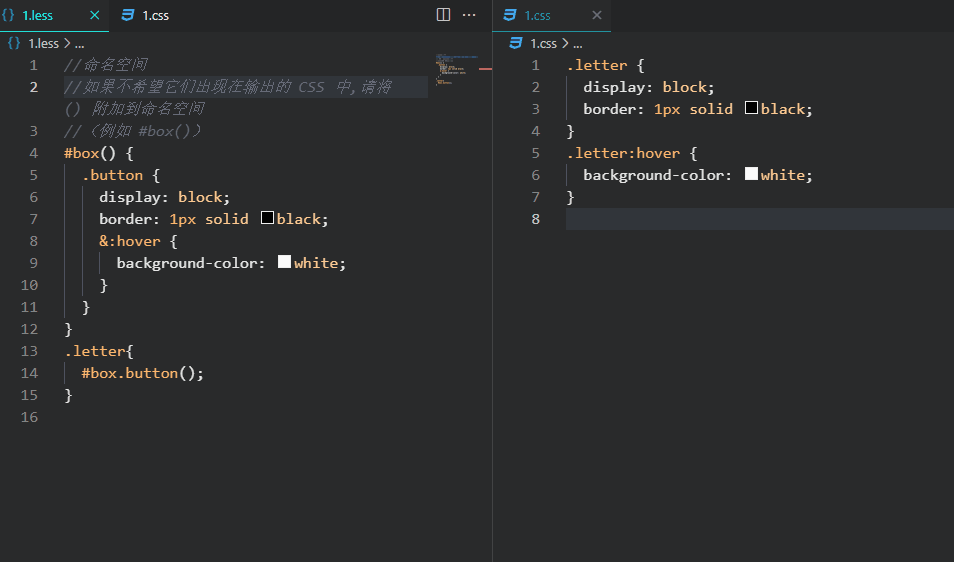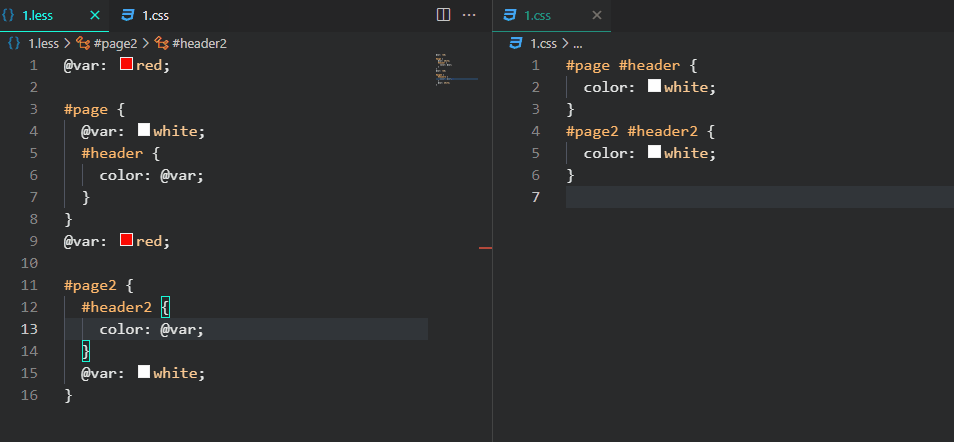less
- Less (Leaner Style Sheets) is a backward compatible CSS extension language.
- Is a dynamic style language, which endows CSS with the characteristics of dynamic language;
Variables
- Variable can customize a series of general styles separately and can be called when necessary.
Less code
// You can customize the style
@width: 10px;
@height: @width + 10px;
// Just call where needed
#header {
width: @width;
height: @height;
}
Compiled CSS code
#header {
width: 10px;
height: 20px;
}

Mixins
- You can introduce the attributes of a defined group of class/id into the attributes of another group of class/id
Less code
// Defined classes
.box{
color: #ccc;
border: 1px solid #ccc;
}
//Introduce the defined class into other classes
#main{
font-size: 12px;
//Property code of the imported box
.box()
}
Compiled CSS code
.box {
color: #ccc;
border: 1px solid #ccc;
}
#main {
font-size: 12px;
/*Property code of the imported box*/
color: #ccc;
border: 1px solid #ccc;
}

Nesting
- Inheritance can be realized by using one selector to nest another selector to write code (imitating the organizational structure of HTML);
- Make the code more concise;
Less code
// Parent box style
.box{
color: #ccc;
// Child box style
.blub{
border: 1px solid #ccc;
}
}
Compiled CSS code
.box {
color: #ccc;
}
.box .blub {
border: 1px solid #ccc;
}

(& represents the parent of the current selector)
Less code
span{
display:block;
//Use & to indicate the parent of the current selector
&::before{
content:"";
display:block;
}
}
Compiled CSS code
span {
display: block;
}
span::before {
content: "";
display: block;
}

@Rule nesting and bubbling
- Nesting (can be nested in the same way as selectors);
- Bubble (compile time = = @ rule will be put in front of = =, and the relative order of other elements in the same rule set will remain unchanged.)
Less code
.box {
width: 500px;
//@After compilation, it will be put in front
@media (min-width: 768px) {
width: 300px;
//@After compilation, it will be put in front
@media (min-resolution: 192dpi) {
width: 300px;
}
}
//@After compilation, it will be put in front
@media (min-width: 1280px) {
width: 800px;
}
}
Compiled CSS code
.box {
width: 500px;
}
@media (min-width: 768px) {
/*box The box is put in the back*/
.box {
width: 300px;
}
}
@media (min-width: 768px) and (min-resolution: 192dpi) {
/*box The box is put in the back*/
.box {
width: 300px;
}
}
@media (min-width: 1280px) {
/*box The box is put in the back*/
.box {
width: 800px;
}
}

Operations
- Arithmetic operators +, -, *, / can operate on any number, color, or variable.
- The calculation result is based on the unit type of the leftmost operand.
- If the unit conversion is invalid or meaningless, the unit is ignored.
- Invalid unit conversion, such as px to cm or rad to%.
- All operands are converted to the same unit (units are different and cannot be converted, +, -, / expressions are reserved)
Less code
@width:5cm + 2mm;
@height:10 - 3% -2mm;
@size:2 * 9px -3cm;
.box{
width:@width; //width: 5.2cm;
height:@height; //height: 7% -2mm;
font-size: @size; //font-size: 18px -3cm;
}

- Multiplication * Less will operate as the number is and will specify a clear unit type for the calculation result. (arithmetic operation of color)
@color:#fff/2;
@size:2px * 9%;
.box{
font-size: @size; //font-size: 18px;
color: @color; //color: #fff/2;
background-color: #100 + #cfc; // background-color: #ddffcc;
}

- calc() does not evaluate mathematical expressions, but evaluates variables and mathematical formulas in nested functions.
@var: 50vh/2;
.box{
width: calc(50% + (@var - 20px)); // width: calc(50% + (25vh - 20px));
}

Escape
- Allows you to use any string as an attribute or variable value;
- Before Less 3.5: writing method @ min16:~"16px"
- Less 3.5 start: writing method @ min16:16px (quotation mark escape is not required)
Less code
@size16:~"16px";
@size:16px;
.box{
font-size: @size; //font-size: 16px;
width: @size16; //width: 16px;
}

Functions
- Less has built-in functions for color conversion, string processing, arithmetic operations, etc. (refer to the less function manual)
Example:
-
Use the percentage function to convert 0.5 to 50%
-
Increase color saturation by 5%
-
The color brightness decreases by 25% and the hue value increases by 8
@base: #f04615;
@width: 0.5;
.box {
width: percentage(@width); // width: 50%;
color: saturate(@base, 5%); //color: #f6430f;
background-color: spin(lighten(@base, 25%), 8);//background-color: #f8b38d;
}

Namespace and accessor
- Namespace (grouping and encapsulating mixins into an attribute space)
- Accessor: (namespace group name)
Example:
//Namespace
//If you don't want them to appear in the output CSS, attach () to the namespace
//(for example #box())
#box() {
.button {
display: block;
border: 1px solid black;
&:hover {
background-color: white;
}
}
}
.letter{
#box.button();
}
Compiled CSS code
.letter {
display: block;
border: 1px solid black;
}
.letter:hover {
background-color: white;
}

Maps
- Starting with less version 3.5, you can also use mixins and rulesets as map s of a set of values.
Example:
//Namespace
#colors() {
primary: blue;
secondary: green;
}
.button {
//Get attribute values by mapping
color: #colors[primary];
border: 1px solid #colors[secondary];
}
Compiled CSS code
.button {
color: blue;
border: 1px solid green;
}

Scope
- The scope in Less is very similar to that in CSS. First, find variables and mixins locally. If not found, inherit from the "parent" scope.
Example:
@var: red;
#page {
@var: white;
#header {
color: @var; // color: white;
}
}

Comments
- /*Multiline comment content*/
- //Single line note content
/* A block comment style comment! */ @var: red; // This line has been commented out! @var: white;
Importing
- If the imported file is less extension, the extension can be omitted
Syntax:
@import "style file"
@import "library"; // library.less @import "typo.css";